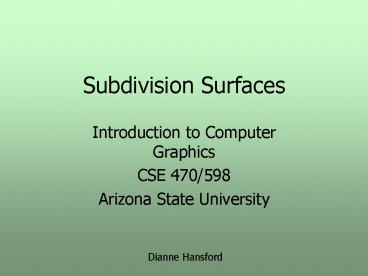Subdivision Surfaces - PowerPoint PPT Presentation
Title:
Subdivision Surfaces
Description:
Subdivision Surfaces Introduction to Computer Graphics CSE 470/598 Arizona State University Dianne Hansford Overview What are subdivision surfaces in a nutshell ? – PowerPoint PPT presentation
Number of Views:180
Avg rating:3.0/5.0
Title: Subdivision Surfaces
1
Subdivision Surfaces
- Introduction to Computer Graphics
- CSE 470/598
- Arizona State University
Dianne Hansford
2
Overview
- What are subdivision surfaces in a nutshell ?
- Advantages
- Chaikens algorithm The curves that started it
all - Classic methods Doo-Sabin and Catmull-Clark
- Extensions on the concept
3
What is subdivision?
Input polygon or polyhedral mesh
Process repeatedly refine (subdivide) geometry
Output smooth curve or surface
http//www.multires.caltech.edu/teaching/demos/jav
a/chaikin.htm
4
Advantages
- Easy to make complex geometry
- Rendering very efficient
- Animation tools easily developed
Pixars A Bugs Life first feature film to
use subdivision surfaces. (Toy Story used NURBS.)
5
Disadvantages
- Precision difficult to specify in general
- Analysis of smoothness very difficult to
determine for a new method - No underlying parametrization
- Evaluation at a particular point difficult
6
Chaikens Algorithm
- Chaiken published in 74An algorithm for high
speed curve generation
a corner cutting method on each edge
ratios 13 and 31
7
Chaikens Algorithm
- Riesenfeld (Utah) 75Realized Chaikens
algorithm an evaluation method for quadratic
B-spline curves (parametric curves) - Theoretical foundation sparked more interest in
idea. - Subdivision surface schemes
- Doo-Sabin
- Catmull-Clark
8
Doo-Sabin
one-level of subdivision
Input polyhedral mesh
many levels of subdivision
9
Doo-Sabin 78
- Generalization of Chaikens idea to biquadratic
B-spline surfaces
Input Polyhedral mesh Algorithm 1) Form
points within each face 2) Connect points to
form new faces F-faces, E-faces, V-faces
Repeat ... Output polyhedral mesh mostly
4-sided faces except some F-
V-faces valence 4 everywhere
10
Doo-Sabin
- Repeatedly subdivide ... Math analysis will say
that a - subdivision schemes smoothness tends to be the
same everywhere but at isolated points. - extraordinary points
- Doo-Sabin non-four-sided patches become
extraordinary points
11
Catmull-Clark
one-level of subdivision
Input polyhedral mesh
many-levels of subdivision
12
Catmull-Clark 78
Generalization of Chaikens idea to bicubic
B-spline surfaces
- Input Polyhedral mesh
- Algorithm
- Form F-vertices centroid of faces vertices
- Form E-points combo of edge vertices and
F-points - Form V-points average of edge midpoints
- Form new faces (F-E-V-E)
- Repeat....
- Output mesh with all 4-sided faces but valence
not 4
13
CC - Extraordinary
- Valence not 4
- 1) Input mesh had valence not 42) Face with
ngt4 sides - Creates extraordinary vertex (in limit)
- (Remember smoothness less there)
14
Lets compare
D-S
C-C
15
Convex Combos
- Note D-S C-C use convex combinations
!(Weighting of each point in 0,1) - Guarantees the following properties
- new points in convex hull of old
- local control
- affinely invariant
- (All schemes use barycentric combinations)
See references at end for exact equations
16
Data Structures
- Each scheme demands a slightly different
structure to be most efficient - Basic structure for mesh must exist plus more
info - Schemes tend to have bias faces, vertices,
edges .... as foundation of method - Lots of room for creativity!
17
Extensions
- Many schemes have been developed since....
interpolation(butterfly scheme)
more control (notice sharp edges)
See NYU reference for variety of schemes
Pixar tailored for animation
18
References
- Ken Joys class noteshttp//graphics.cs.ucdavis.e
du - Gerald Farin DCHThe Essentials of CAGD, AK
Petershttp//eros.cagd.eas.asu.edu/farin/essbook
/essbook.html - Joe Warren Heinrik Weimer www.subdivision.org
- NYU Media Labhttp//www.mrl.nyu.edu/projects/subd
ivision/ - CGW articlehttp//cgw.pennnet.com/Articles/Articl
e_Display.cfm?SectionArticlesSubsectionDisplay
ARTICLE_ID196304































